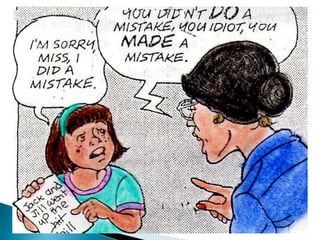
Linguistic Factors Presentation [Autoguardado]
- 2. LINGUISTIC FACTORS Cross – LinguisticInfluence and learnerlanguage
- 3. AGREEMENT OR DISAGREEMENT ACTIVITY. Errorsanalysis describes and explainwhylearnersmakeerrors. Error isthecondition of havingincorrector false knowledge. Mistakeis a deficiency in competence. Intralingual transfer happenswithinthe target languageitself. Interlingual transfer happensfromthenativelanguagetothesecond . Error correctiondoesnotpermitusidentifystrategieswhichlearners use in languageteaching. KEY CONCEPTS
- 4. HISTORICAL BACKGROUND 1.1. CAH AND CLI THEORIES 2. PROVOCATIVE STATEMENTS 3. ERRORS AND MISTAKES. 3.1 CATEGORIES FOR DESCRIPTION OF ERRORS 3.2. SOURCES OF ERRORS. 4. PEDAGOGICAL IMPLICATIONS 4.1. ERROR CORRECTIONS: WRITTEN AND SPOKEN. 5. CONCLUSIONS. CONTENTS
- 5. 1.1 THE CONTRASTIVE ANALYSIS HYPOTHESIS AND THE CROSS- LINGUISTIC INFLUENCE CAH CLI The CAH studiestwolanguages in contrast. Behavioristic and structuralistaproaches. Interference L1 with L2. Hierarchy of difficulty. Fries,1952; Stockwell, Bowen, Martin,1965. The CLI recognizestheimportance of L1 in learning L2 or more. Intralingual - interlingual factors. Odlin, 2003; Kellerman,1995; Kellerman and Sharwood- Smith, 1986.
- 6. PROVOCATIVE STATEMENTS LET’S THINK ABOUT THE PAST!!! Do yourememberwhenyoulearnedto… Swim Skate Ride a motorcycle Drive a car
- 7. “ Learningisfundamentally a processthatinvolvesthemaking of mistakes” Brown, H.D (2004)
- 8. DIFFERENCES BETWEEN MISTAKES AND ERRORS MISTAKE ERROR Itis a failuretoutilize a knownsystemcorrectly. Itis a slip of thetongue. The speaker recognizes and correctsit. Itisnot a deficiency in competence. Itisthecondition of havingincorrector false knowledge. Itisnotrecognizedbythelearner. An error can notbeself-corrected. Itreveals a portion of thelearner’scompetence in the L2.
- 9. AUDIO
- 10. a. Categories and levels. ByCorder (1973) 1. Omission: of somerequiredelement. Morphologicalomission. “A strongthinghappento me yesterday” Syntacticalomission. “ ? Mustsayalsothenames” 2. Addition: In morphology. “Thebooksisthere” In syntax. “The London” In lexicon. “I stayedthereduring 5 yearsago. Identifying and describingerrors
- 11. 3. Substitution In morphology: “My friendisoldestthan me. In lexicon: “I lost my road” 4. Ordering. In pronunciation. “Fifnisicant” forsignificant. “Prulal” for plural. In morphology. “getupping” forgetting up. In syntax. “he is a dearto me friend”
- 12. B. Covert, overt, Local and Global A: Who are you? B: I’m fine, thankyou. A: Wherewere he? B: He gotoCanada A: “a scissors” Covert Local Overt Global Local
- 13. CATEGORIES:OMISSION, ADDITION, SUBSTITUTION, ORDERING I start to studying English in this University. Because the English is important for in this moment. … the many technologies, because a new fields of the technology need the understand very well the English. (Global, Overt) At the moment in the university the English for me in the first semester is confuse because in my school don´tprepare very well the homeworks, the works of the classroom. STUDENT´S ERROR ANALYSIS
- 15. Teachers can givedelayedfeedback in thefollowingsituations…
- 17. Teachers can correctlearners in differentwaysaccordingtothetype of taskswhichthey do, forexample…
- 18. Someadvantages of self-correction and peer correction are…
- 19. Somedisadvantages of self-correction and peer correction are…